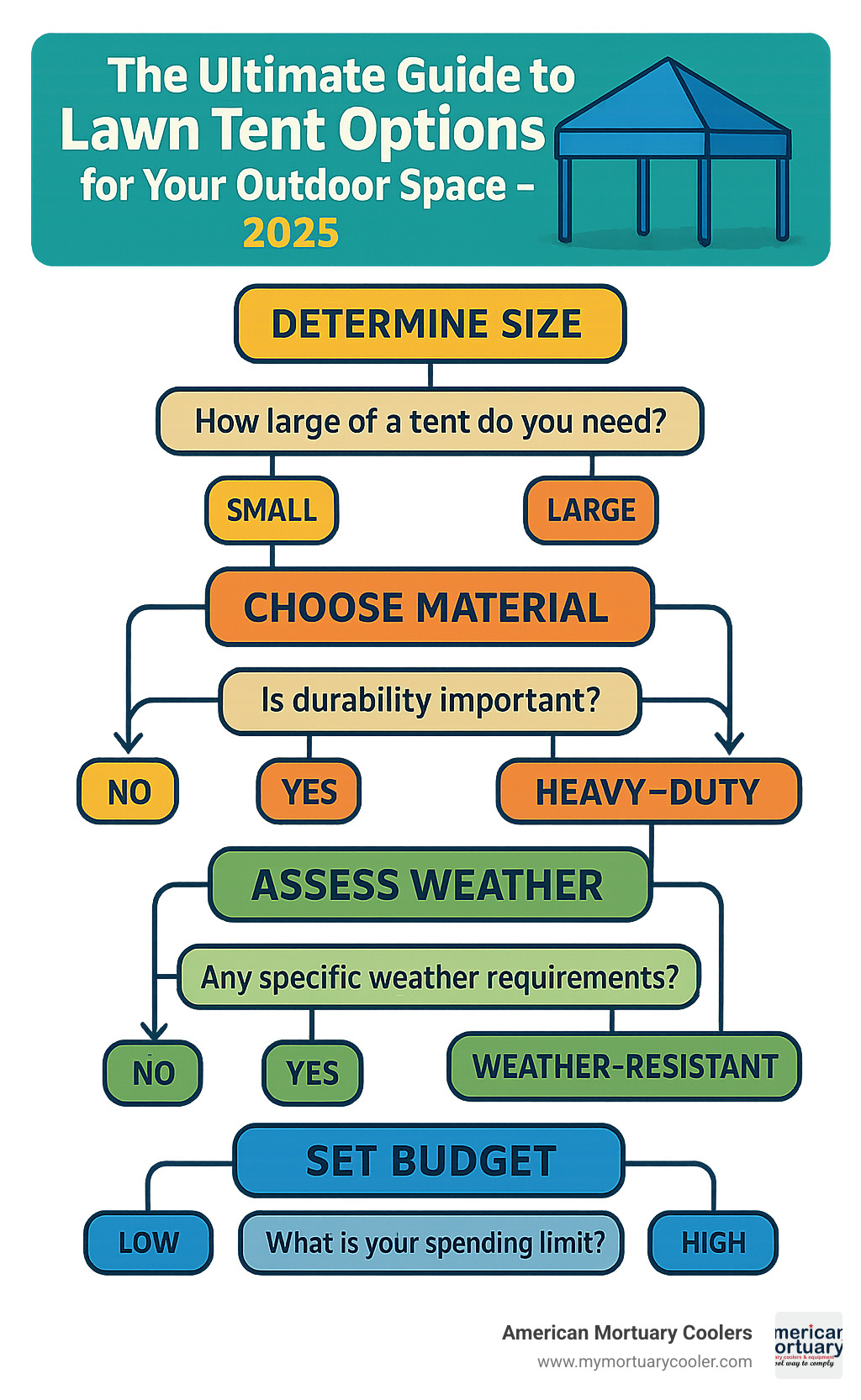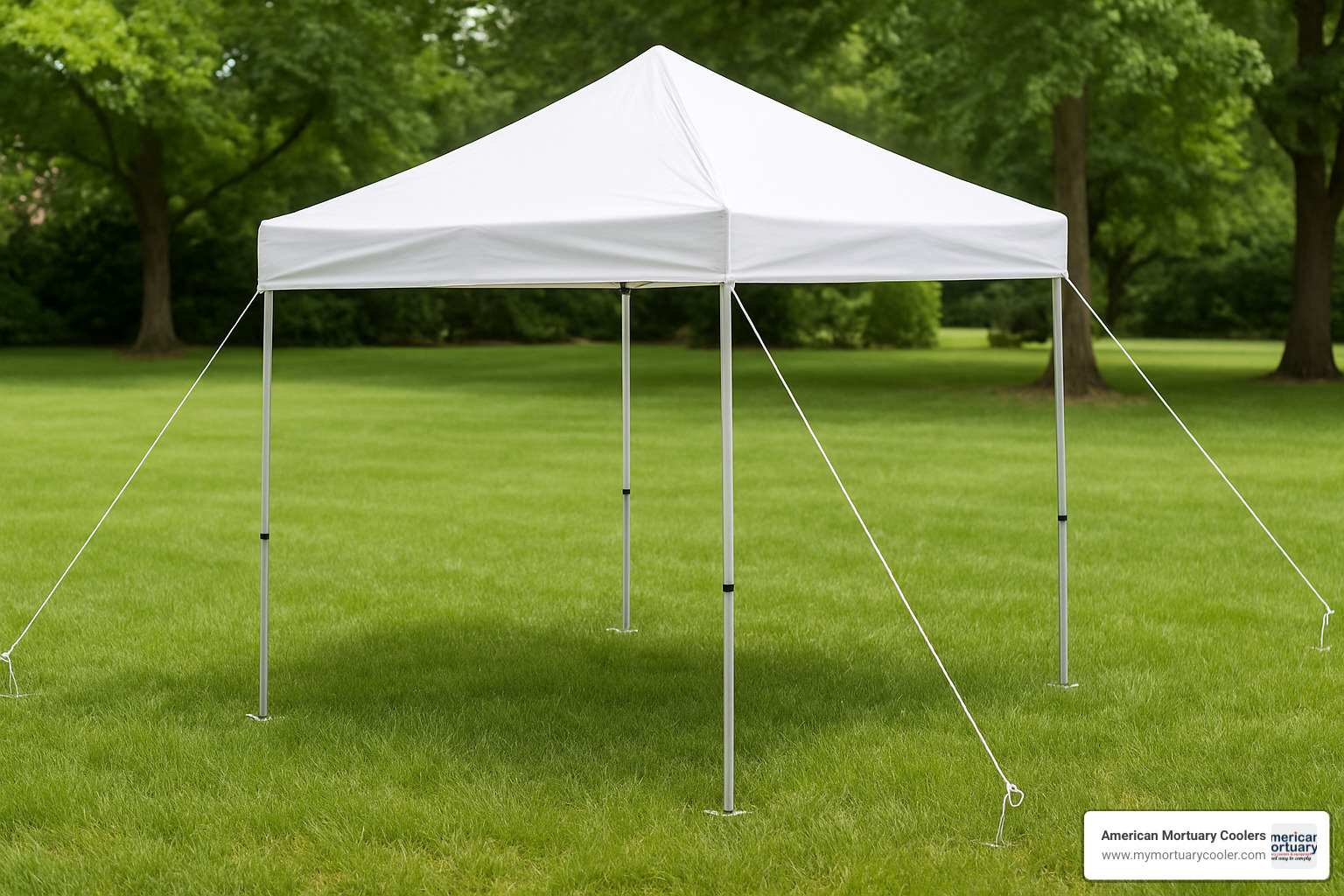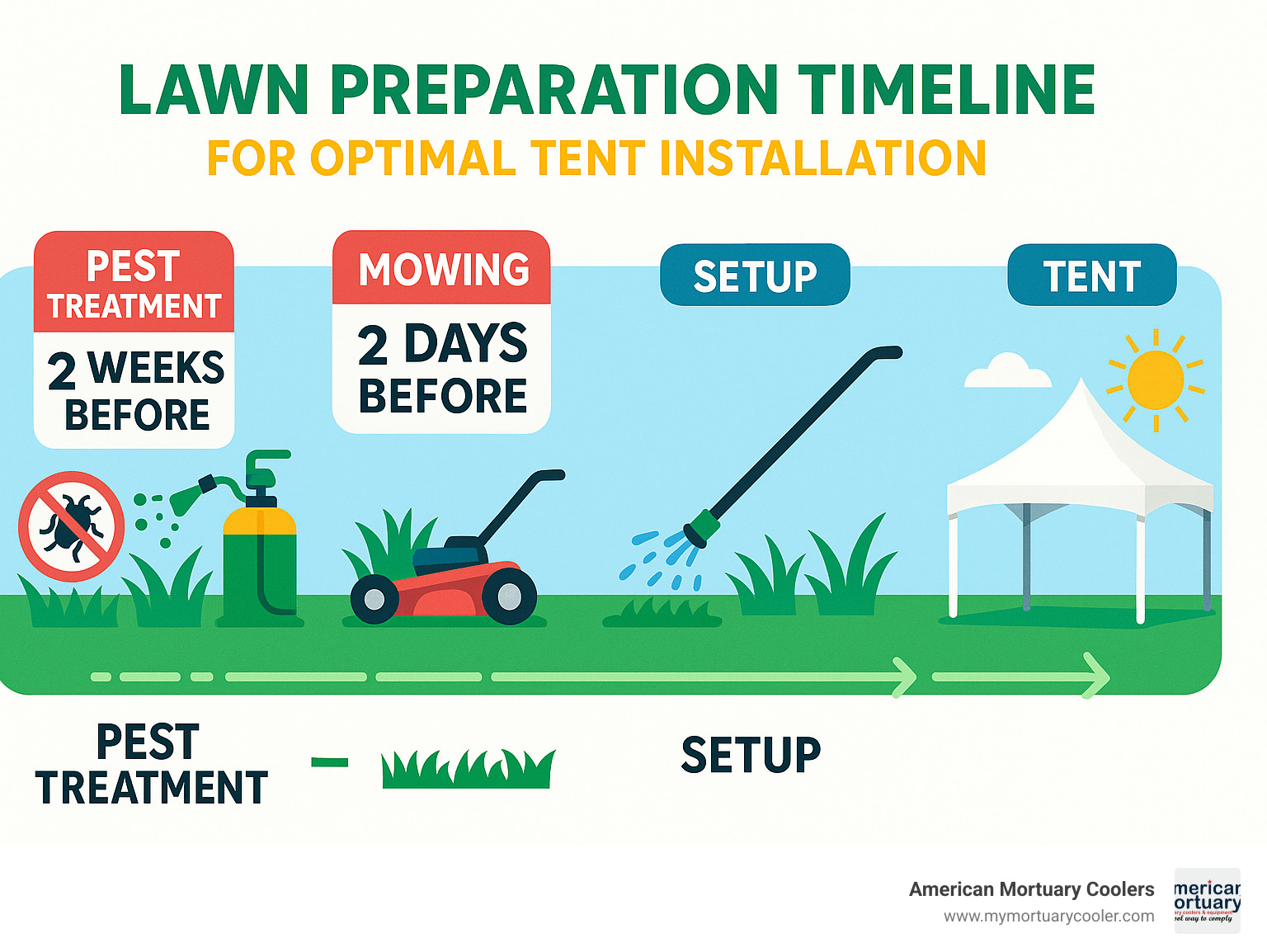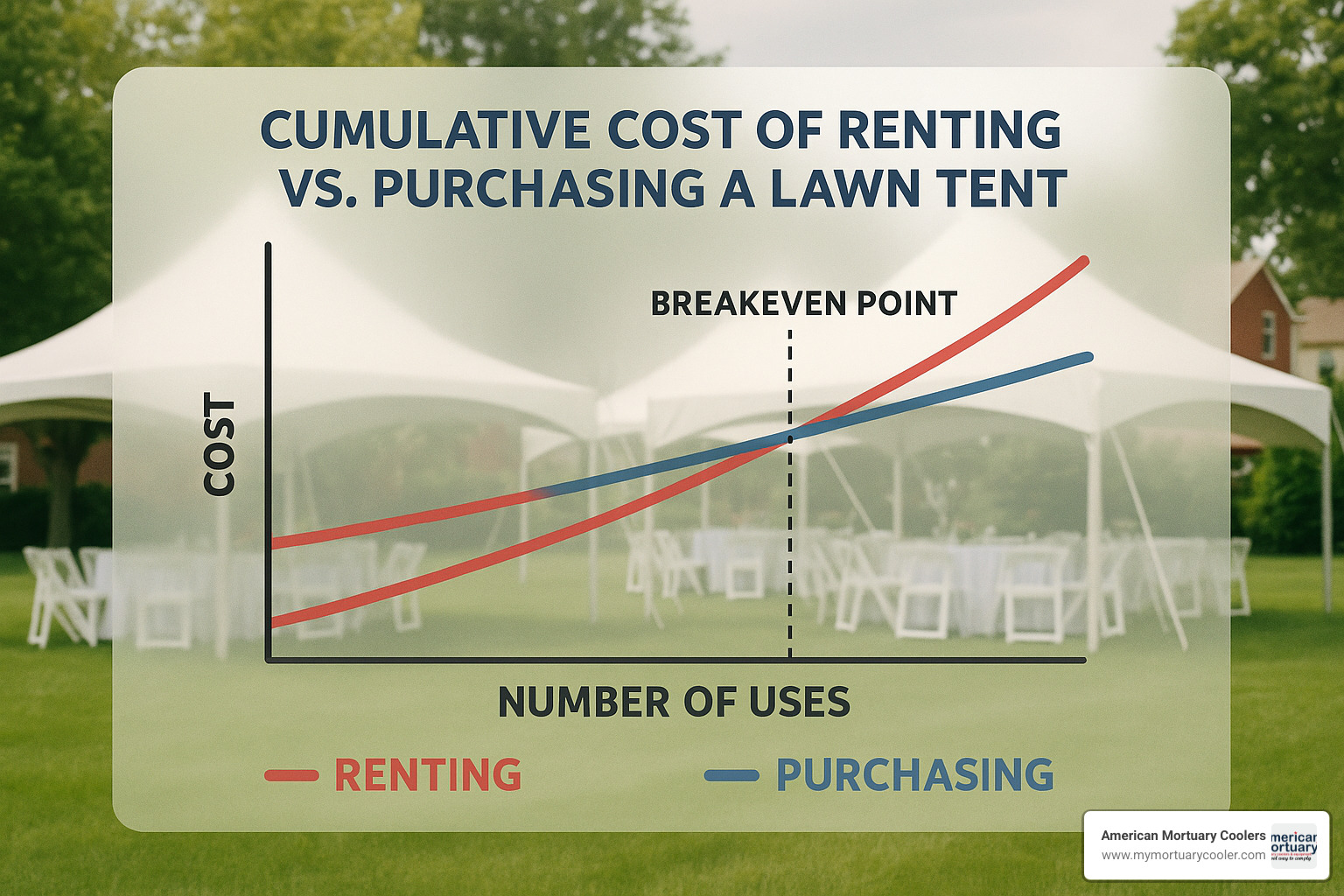Why Lawn Tents Are Essential for Professional Outdoor Events
A lawn tent provides temporary shelter and weather protection for outdoor events, ranging from backyard gatherings to professional ceremonies. These versatile structures serve multiple purposes across industries - from funeral services requiring dignified graveside coverage to corporate events needing branded promotional spaces.
Quick Lawn Tent Guide:
- Pop-up canopies (10x10 ft) - Best for small gatherings up to 8 people
- Party tents (10x20 ft+) - Ideal for weddings, receptions, large events
- Industrial shelters - Heavy-duty options for work sites and storage
- Inflatable tents - Easy setup, customizable with logos and colors
- Price range - $82-$1,812 for purchase, rental rates vary by size and duration
Whether you're hosting a memorial service, corporate function, or community event, the right lawn tent transforms any outdoor space into a professional venue. The VEVOR 10x10 camping gazebo accommodates up to 8 people and features waterproof 300D Oxford fabric with UV protection.
Key considerations include:
- Ground preparation and anchoring requirements
- Weather resistance ratings (wind, rain, UV protection)
- Setup complexity and time requirements
- Storage and maintenance needs
As professionals with experience in outdoor event equipment, we've seen how the right lawn tent selection can make or break professional gatherings. Quality materials and proper setup are crucial for any successful outdoor event.

Quick look at lawn tent:
Understanding Lawn Tents: Definitions & Primary Uses
Think of a lawn tent as your outdoor room that pops up wherever you need it. These temporary shelters are specifically designed for grass surfaces and open spaces, creating instant coverage for everything from graduation parties to professional business events.
What makes lawn tents special is their focus on coverage and convenience rather than camping comfort. While camping tents are built for sleeping bags and backpacking, a lawn tent is all about creating usable space where people can gather, eat, and celebrate without worrying about sudden rain showers or blazing sun.
The versatility really shines when you see them in action. Backyard events like family reunions and birthday barbecues become much more comfortable when everyone has a shaded spot. Wedding ceremonies take on a professional outdoor venue feel, while industrial lunchrooms give workers a proper break space right on the job site.
We've seen graveside services transformed by the dignity and comfort a well-placed lawn tent provides during difficult times. Community fairs and farmers markets rely on them for vendor booths, and outdoor storage becomes a breeze when you need to protect equipment or create temporary workspace.
Companies like Southern Comfort Shelters have been proving this versatility for over 30 years, offering everything from small 10x10 canopies to massive warehouse-sized covers.
How a lawn tent differs from camping and marquee models
Lawn tents are built around frame construction - usually steel or aluminum - which means you get stable coverage without center poles that camping tents often use. This gives you much more usable space inside.
The open floor design is another key difference. No built-in flooring means they're designed to sit directly on grass, letting you use the natural ground while still getting weather protection above. Quick assembly is built into the design philosophy - these are meant for temporary use where you can set up and take down without calling in a construction crew.
Weather focus drives everything about how they're built. Instead of the insulation and wind resistance you'd want in a camping tent, lawn tents prioritize rain and sun protection for groups of people who need to stay comfortable during events.
Camping tents are all about portability and sleeping comfort for outdoor trips. Marquee tents go the other direction - they're larger, semi-permanent structures that often need professional installation. Lawn tents hit that sweet spot in between for temporary outdoor events.
Core situations that call for a lawn tent
Family gatherings are probably the most common reason people find lawn tents. When you're hosting a family reunion and need space for everyone from toddlers to grandparents, a 10x20 ft tent creates that perfect gathering spot where conversations can happen regardless of weather surprises.
Corporate promotions have acceptd lawn tents as mobile brand headquarters. Trade shows, customer appreciation events, and outdoor marketing campaigns all benefit from having a professional-looking branded space that can be set up anywhere there's grass or pavement.
Construction sites present unique challenges that lawn tents solve beautifully. Industrial versions serve as temporary lunchrooms and meeting spaces, giving workers proper shelter without the expense of permanent buildings.
Funeral services require a special combination of dignity and practicality that quality lawn tents provide perfectly. Our experience at American Mortuary Coolers has shown us how crucial proper shelter is for maintaining ceremony dignity, regardless of weather conditions.
Choosing the Right Lawn Tent for Your Space
Finding the perfect lawn tent for your space starts with understanding your needs and measuring carefully. We've helped countless families and businesses choose the right size, and there's definitely a science to getting it right.
Size matters more than you might think. A cramped tent makes guests uncomfortable, while an oversized one can feel empty and unwelcoming. The sweet spot depends on your guest count, planned activities, and the natural flow you want to create.
Here's what we've learned works best for different gatherings:
For intimate family gatherings, an 8x8 ft tent comfortably seats 4-6 people around a small table. Small parties and vendor booths do well with 10x10 ft tents (6-8 people), while medium events like receptions need 10x20 ft spaces for 15-20 guests. Larger family reunions call for 15x15 ft tents (20-25 people), and major ceremonies require 20x40 ft structures for 50 or more attendees.
Don't forget the footprint versus headroom balance. You need extra space beyond your tent's actual size - typically 2-3 feet on all sides for proper staking and guy ropes. Always check for overhead obstacles like tree branches or power lines before setup day arrives.
Site measurement is absolutely crucial. Walk your space with a measuring tape, not just your best guess. Consider delivery access for larger tents, and check if your local area requires permits for bigger temporary structures.
| Tent Size | Capacity | Best For | Typical Price Range |
|---|---|---|---|
| 10x10 ft | 6-8 people | Small gatherings, vendor booths | $82-$200 |
| 20x40 ft | 50+ people | Weddings, large ceremonies, corporate events | $800-$1,800 |
Popular lawn tent types and their pros & cons
Pop-up canopies are the workhorses of the tent world. They set up in about 5 minutes, won't break your budget ($82-$200), and work perfectly for tailgating or small backyard parties. The trade-off? They're not built for serious wind, and you're limited on coverage area.
Party tents bring the elegance factor. These larger structures look professional, offer extensive coverage, and can be customized to match your event theme. They do require more setup time and storage space, plus they'll cost more upfront. But for weddings, corporate events, or significant family gatherings, they're worth every penny.
Inflatable tents are the conversation starters. Kids love them, they're easy to transport, and you can add custom logos for business events. Just remember you'll need a power source, and sharp objects are their natural enemy.
Industrial shelters are built like tanks. Companies like Southern Comfort Shelters even offer blast-resistant options rated up to 6 psi for extreme industrial applications.
Picking a lawn tent size that fits—step-by-step
Start with your guest count, then add 20% for breathing room. Nobody enjoys being packed in like sardines, especially during emotional events like memorial services.
Plan your furniture layout before you buy. Tables, chairs, serving areas, and walkways all need space. If you're planning dancing or presentations, factor that in too.
Consider the ceremony flow. For funeral services, we recommend 15-20 square feet per person. This maintains the dignity and comfort that families deserve during difficult times.
Measure twice, order once. Check your actual space dimensions, including clearance for stakes and setup. Don't forget about access routes for delivery trucks if you're renting a larger tent.
Research local requirements. Some areas restrict tent sizes without permits, and it's much easier to handle this upfront than scramble later.
The right lawn tent transforms any outdoor space into a welcoming venue. Take the time to choose thoughtfully, and your guests will appreciate the comfort and protection you've provided.
Key Features & Materials That Matter
Material quality directly impacts lawn tent performance and longevity. The VEVOR camping gazebo uses 300D Oxford fabric with steel frames, designed to be waterproof, UV-proof, and wind-resistant - perfect for various weather conditions.
Frame Materials:
- Steel frames - Maximum strength and stability, heavier weight
- Aluminum frames - Lightweight, corrosion-resistant, moderate strength
- Composite materials - Balance of weight and strength, higher cost
Fabric Options:
- 300D Oxford fabric - Standard durability, waterproof coatings available
- PVC-coated materials - Excellent waterproofing, easy cleaning
- Sunbrella acrylic - Premium UV resistance, fade-resistant colors
The Hill & Lawn Tent 15x15 model features Sunbrella acrylic material with reinforced leather corners, priced at $1,811.60 - demonstrating the premium end of material quality.
Critical features to evaluate:
- UV rating - Look for UPF 50+ protection
- Waterproof coatings - Minimum 1000mm water column rating
- Seam sealing - All seams should be sealed or welded
- Reinforced corners - Stress points need extra material or leather patches
For more detailed information about UV fabric durability, check our Scientific research on UV fabric durability.
Weather resistance checklist for your lawn tent
Wind Load Considerations:
- Secure anchoring with stakes or weights
- Guy ropes at all attachment points
- Frame strength appropriate for local wind conditions
- Emergency takedown plan for severe weather
Rain Protection:
- Sloped roof design for water runoff
- Sealed seams and waterproof coatings
- Proper drainage around tent perimeter
- Quick-dry materials to prevent mold
Sun Exposure Management:
- UV-resistant fabric treatments
- Light-colored materials reflect heat
- Adequate ventilation to prevent heat buildup
- Consider orientation to minimize direct sun exposure
Snow Load Capacity: Industrial tents may need to handle significant snow loads. Southern Comfort Shelters provides structures designed for various weather extremes.
Accessories & add-ons that boost comfort
Essential Accessories:
- Mesh screens - Bug protection while maintaining airflow
- Sidewalls - Privacy and additional weather protection
- Flooring options - Protect guests from wet or uneven ground
- Lighting kits - Extend usable hours into evening
- Heating elements - Comfort during cooler weather
The VEVOR tent includes mesh windows with B3 gauze netting for bug-free ventilation while allowing scenic views - a thoughtful design feature.
Professional Improvement Options:
- Custom printing and branding
- Electrical hookups for lighting and sound
- Climate control systems for larger tents
- Decorative elements and drapery
For funeral services, we often recommend subtle, dignified accessories that improve comfort without drawing attention from the ceremony. More information about complementary equipment is available in our guide to funeral flower stands.

Setup, Anchoring & Maintenance Best Practices
Proper ground preparation is crucial for lawn tent success. Research shows that pest treatment should be applied at least two weeks before your event, and lawn preparation significantly impacts tent stability and guest comfort.
Ground Preparation Timeline:
- 2 weeks before: Apply pest control spray or granules
- 1 week before: Inspect and fill mole holes and divots
- 2 days before: Mow lawn and remove debris
- Day of setup: Remove morning dew with hose-drag method

Essential Preparation Steps:
- Pest control - Use hose-connected sprayer for even coverage
- Level ground - Fill holes and remove obstacles
- Mow grass - Optimal height 2-3 inches for stake penetration
- Clear debris - Remove rocks, sticks, and other hazards
This preparation method, borrowed from golf course maintenance techniques, ensures a professional foundation for your tent installation.
Step-by-step lawn tent setup & takedown
Setup Process:
- Unfold frame - Lay out completely, check all components
- Raise legs - Extend to desired height, ensure level
- Secure top - Attach fabric, ensure proper tension
- Install guy ropes - Attach at all designated points
- Final safety check - Test stability, adjust as needed
The VEVOR pop-up design allows assembly without consulting a manual - several users found the setup straightforward and intuitive.
Takedown Best Practices:
- Remove accessories first (sidewalls, decorations)
- Loosen guy ropes gradually to maintain control
- Clean and dry all components before storage
- Inspect for damage or wear during disassembly
Anchoring a lawn tent for wind, rain, and sun
Anchoring Options by Surface:
- Grass/soil - Steel stakes, spiral anchors, sandbags
- Concrete - Water barrels, concrete blocks, weighted bases
- Mixed surfaces - Combination approach based on conditions
Southern Comfort Shelters recommends checking cables, webbing, and frame hardware yearly, tightening wire clamps and turnbuckles as needed for long-term installations.
Weather-Specific Anchoring:
- High winds - Double stake count, add guy ropes
- Heavy rain - Ensure proper drainage, check stake holding power
- Hurricane preparation - Remove covers, secure or relocate frames
Professional-grade anchoring becomes critical for larger installations. Industrial applications may require engineered anchoring solutions.
Buying vs. Renting Lawn Tents: Costs, Brands, and Customization
When it comes to getting your hands on a quality lawn tent, you've got two main paths: buying or renting. Each approach has its sweet spot depending on how often you'll use it and what your specific needs are.
Purchase prices vary quite a bit based on what you're looking for. A basic pop-up canopy in the 10x10 size will run you anywhere from $82 to $200 - perfect for occasional backyard gatherings. If you're stepping up to a mid-range party tent, expect to invest $200 to $600. For professional-grade structures that can handle frequent use and tougher weather, you're looking at $600 to $1,800 or more.
The brand landscape offers some solid choices. Outsunny has made quite a name for itself with popular 10x10 pop-up canopies - they're selling over 300 units monthly on Amazon alone. VEVOR focuses on durability with their camping gazebos featuring steel frames and 300D Oxford fabric. ShelterLogic covers the spectrum from basic canopies to large enclosure kits, while Quik Shade specializes in commercial-grade instant canopies. At the premium end, Hill & Lawn offers high-end tents with Sunbrella materials.
For detailed specifications and comparisons, you can check out the PartytentBase.pdf resource.
Customization options have really expanded in recent years. Logo printing lets you brand corporate events professionally, while color selection helps match event themes or company colors. Size modifications accommodate specific space requirements, and accessory packages provide complete setup solutions. Inflatable lawn tents offer particularly extensive customization - you can modify size, color, logos, and themes, often with two-year warranties from specialized manufacturers.

Advantages & disadvantages of owning a lawn tent
Owning your own tent makes financial sense if you're using it regularly. Most quality lawn tents pay for themselves after just 3-5 uses compared to rental costs. You'll always have it available when needed, can customize it exactly how you want, and become familiar with the setup process.
The downsides of ownership are pretty straightforward. Storage space becomes a real consideration since quality tents weigh 35-50 pounds and need proper storage to prevent damage. You're responsible for all maintenance, cleaning, and repairs. The initial investment can feel steep, especially for larger or professional-grade models.
At American Mortuary Coolers, we understand the value of owning quality equipment that you can count on. Just like our custom mortuary coolers, a well-chosen lawn tent becomes a reliable tool that serves you for years when properly maintained.
Renting a lawn tent—what to expect
Rental services solve the storage and maintenance headaches completely. You get access to larger sizes without the massive upfront investment, and professional setup is often included in the rental price. The rental company handles all the maintenance, cleaning, and repairs.
Party In A Tent Charlotte offers some customer-friendly policies that show how the rental industry has evolved. They provide non-refundable deposits that can be applied to future events within 12 months, plus optional Sunday and same-day delivery services for those last-minute needs.
Typical rental arrangements include delivery 1-2 days before your event, with pickup scheduled 1-2 days afterward. Setup services are usually included, though it's worth confirming this upfront. Always inspect the tent thoroughly before accepting delivery - damage policies vary, and you don't want to be charged for pre-existing issues.
Budget breakdown for your ideal lawn tent
Planning your purchase budget works best when you think in percentages. The base tent cost should represent 60-70% of your total budget. Essential accessories like stakes, guy ropes, and basic sidewalls typically account for 20-25%. Anchoring materials for your specific ground conditions take up 5-10%, and storage solutions round out the remaining 5-10%.
Rental budgeting involves different considerations. Beyond the base rental fee, factor in delivery charges, setup and takedown services, and insurance or damage deposits. Extended rental periods can add up quickly if your event runs longer than the standard package.
Hidden costs can catch you off guard regardless of which route you choose. Permit fees apply to large installations in many areas. Ground preparation might require professional help depending on your site conditions. Difficult anchoring situations - like rocky soil or high wind areas - may need specialized equipment. For rentals, cleaning fees or damage charges can appear if the tent isn't returned in good condition.
The key is being realistic about your total costs upfront, whether you're buying or renting. Just like we do with our custom mortuary equipment at American Mortuary Coolers, transparency about all costs helps you make the best decision for your specific situation.
Frequently Asked Questions About Lawn Tents
When it comes to lawn tents, we hear the same questions over and over again. After years of working with outdoor event equipment, we've learned what really matters to people planning their gatherings. Let's tackle the big three questions that keep coming up.
What lawn tent material lasts longest in harsh sun?
If you're dealing with brutal summer sun, Sunbrella acrylic fabric is your best friend. The Hill & Lawn Tent uses this premium material with reinforced leather corners, and there's a good reason it costs $1,811.60 - it's built to last. This stuff can handle years of UV punishment without fading or breaking down.
But let's be realistic about budgets. Not everyone needs to spend that much. 300D Oxford fabric with UV coatings gives you solid protection at a fraction of the cost. The VEVOR camping gazebo uses this material and offers great value for most situations.
Here's what to look for: UPF 50+ ratings and fade-resistant treatments. These aren't just marketing terms - they actually mean something. Avoid basic polyester without UV protection unless you enjoy replacing your tent every season. Trust us, that cheap material will start looking like a faded beach towel after one summer.
How do I keep a lawn tent stable on concrete?
Concrete is tricky because you can't just hammer stakes into it. You need to get creative with weighted anchoring systems. Think of it like holding down a giant umbrella in a windstorm - you need serious weight.
Water barrels work great if you have access to a hose. Fill up some 55-gallon drums and you've got serious holding power. Concrete blocks are the classic solution - stack them up and secure them to your frame points. They're not fancy, but they work.
For easier handling, sandbags give you flexibility. You can stack them, move them around, and they conform to uneven surfaces. Commercial tent weights are purpose-built for this job, but they cost more.
Plan for 40-50 pounds of weight per anchor point under normal conditions. If it's windy, you'll need more. We've seen too many tents become expensive kites because someone skimped on anchoring.
Can I install a large lawn tent without professional help?
Most lawn tents up to 10x20 feet can be handled by a motivated group of friends or family. The VEVOR pop-up design is so straightforward that users report setting it up without even reading the manual. That's the beauty of good design.
But here's where it gets complicated: larger installations are a different beast entirely. Once you're talking about serious size, you're dealing with complex frame assembly, proper anchoring calculations, and safety considerations with those big fabric panels catching wind.
Southern Comfort Shelters provides professional installation for industrial applications, and there's wisdom in knowing when to call the pros. Local permits and code compliance become issues with larger structures too.
The sweet spot seems to be 2-4 people with basic tools for medium-sized setups. Everyone can help, it becomes a team effort, and you're not risking injury or damage to expensive equipment. Plus, you'll actually know how to take it down properly when the event's over.
At American Mortuary Coolers, we understand the importance of reliable, professional equipment. While we specialize in mortuary equipment, we appreciate quality construction and proper installation - whether it's a cooling system or a lawn tent for outdoor services.
Conclusion
Choosing the perfect lawn tent doesn't have to be overwhelming when you focus on what really matters. After exploring everything from materials to setup techniques, it comes down to finding that sweet spot between your needs, budget, and the weather conditions you'll face.
Quality materials make all the difference. Whether you go with 300D Oxford fabric for solid everyday protection or splurge on Sunbrella acrylic for premium UV resistance, investing in proper materials saves you money and headaches down the road. We've seen too many events dampened (literally) by cheap tents that couldn't handle a summer afternoon shower.
Smart sizing beats going too big or too small. That 10x10 lawn tent might seem perfect until you realize your family reunion actually needs a 10x20 to keep everyone comfortable. Take the time to measure your space and count your guests - your future self will thank you.
Safety should never be negotiable. Proper anchoring isn't just about keeping your tent upright - it's about protecting your guests and your investment. Whether you're using stakes in soft ground or water barrels on concrete, give your tent the foundation it deserves.
The funeral industry has taught us at American Mortuary Coolers that when people gather for important moments, the details matter tremendously. A wobbly tent or inadequate weather protection can turn a meaningful gathering into an uncomfortable memory. That's why we apply the same attention to durability and reliability that goes into our mortuary equipment when we think about any professional outdoor setup.
Eco-friendly options are becoming more accessible as manufacturers recognize the importance of sustainable materials. It's encouraging to see the industry moving toward recyclable fabrics and responsible production methods.
From our Tennessee headquarters, we've delivered custom solutions across the Southeast, Southwest, and beyond. This experience has shown us that whether you're planning a graveside service, corporate event, or backyard celebration, the right lawn tent transforms any outdoor space into something special.
The investment in quality pays off in countless ways - successful events, comfortable guests, and that peace of mind knowing your gathering is protected no matter what the weather brings. When you're ready to explore professional-grade equipment and furnishings, our comprehensive guide to funeral home furnishings offers additional insights into creating dignified, functional spaces.
Your outdoor event deserves the foundation that only a well-chosen lawn tent can provide.
















